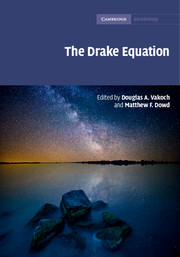Book contents
- The Drake EquationEstimating the Prevalence of Extraterrestrial Life through the Ages
- Cambridge Astrobiology
- The Drake Equation
- Copyright page
- Dedication
- Contents
- Contributors
- Foreword
- Preface
- Book part
- Introduction
- 1 Rate of formation of stars suitable for the development of intelligent life, R*, pre-1961
- 2 Rate of formation of stars suitable for the development of intelligent life, R*, 1961 to the present
- 3 Fraction of stars with planetary systems, fp, pre-1961
- 4 Fraction of stars with planetary systems, fp, 1961 to the present
- 5 Number of planets, per solar system, with an environment suitable for life, ne, pre-1961
- 6 Number of planets, per solar system, with an environment suitable for life, ne, 1961 to the present
- 7 Fraction of suitable planets on which life actually appears, fl, pre-1961
- 8 Fraction of suitable planets on which life actually appears, fl, 1961 to the present
- 9 Fraction of life-bearing planets on which intelligent life emerges, fi, pre-1961
- 10 Fraction of life-bearing planets on which intelligent life emerges, fi, 1961 to the present
- 11 Fraction of civilizations that develop a technology that releases detectable signs of their existence into space, fc, pre-1961
- 12 Fraction of civilizations that develop a technology that releases detectable signs of their existence into space, fc, 1961 to the present
- 13 Length of time such civilizations release detectable signals into space, L, pre-1961
- 14 Length of time such civilizations release detectable signals into space, L, 1961 to the present
- Afterword
- Index
- References
4 - Fraction of stars with planetary systems, fp, 1961 to the present
Published online by Cambridge University Press: 05 July 2015
- The Drake EquationEstimating the Prevalence of Extraterrestrial Life through the Ages
- Cambridge Astrobiology
- The Drake Equation
- Copyright page
- Dedication
- Contents
- Contributors
- Foreword
- Preface
- Book part
- Introduction
- 1 Rate of formation of stars suitable for the development of intelligent life, R*, pre-1961
- 2 Rate of formation of stars suitable for the development of intelligent life, R*, 1961 to the present
- 3 Fraction of stars with planetary systems, fp, pre-1961
- 4 Fraction of stars with planetary systems, fp, 1961 to the present
- 5 Number of planets, per solar system, with an environment suitable for life, ne, pre-1961
- 6 Number of planets, per solar system, with an environment suitable for life, ne, 1961 to the present
- 7 Fraction of suitable planets on which life actually appears, fl, pre-1961
- 8 Fraction of suitable planets on which life actually appears, fl, 1961 to the present
- 9 Fraction of life-bearing planets on which intelligent life emerges, fi, pre-1961
- 10 Fraction of life-bearing planets on which intelligent life emerges, fi, 1961 to the present
- 11 Fraction of civilizations that develop a technology that releases detectable signs of their existence into space, fc, pre-1961
- 12 Fraction of civilizations that develop a technology that releases detectable signs of their existence into space, fc, 1961 to the present
- 13 Length of time such civilizations release detectable signals into space, L, pre-1961
- 14 Length of time such civilizations release detectable signals into space, L, 1961 to the present
- Afterword
- Index
- References
Summary
Of the Drake Equation's seven factors, fp, the fraction of stars with planets, is the one on which we have made the most progress. Since 1961, we have gone from ignorance to a fairly reliable determination of what this number is. Our progress has occurred in three phases. In the first, which lasted for more than thirty years after 1961, astronomers were limited to speculation and probabilities, based on the Copernican principle and their growing understanding of processes that led to the formation of our solar system. The second phase began in 1995, when the first exoplanet was discovered using the Doppler method, which kicked a new research field into high gear. Excitement mingled with confusion as hot Jupiter-like planets with highly eccentric orbits were found, planets with unprecedented properties. The next decade and a half saw a steady march of the detection limit from Jupiter mass to Neptune mass and more recently to super-Earths, exoplanets with two-to-five times Earth's mass. The census grew from a few to over five hundred. The third phase of exoplanet discovery came with the 2009 launch of the Kepler satellite. Astronomers began to use the transit or eclipse method to detect planets smaller than Earth and, as of 2014, they have found more than 3,000 planetary candidates, about 300 of which are similar to or smaller than Earth. Both the Doppler and the transit methods provide information on potential habitability, and taken together they yield a mean exoplanet density. There is remarkable agreement in the exoplanet count derived from three different detection methods: Doppler, transits, and microlensing. With an uncertainty factor of two, there is an exoplanet for every sequence star, and most of them are small, terrestrial, and orbit red dwarfs. The projected number of terrestrial planets around main sequence stars in the Milky Way is about 200 billion. These recent results put the Drake Equation on firmer epistemological footing than ever before, a trend that will continue as exoplanet research moves toward the detection of biomarkers and the imprint on exoplanet atmospheres of microbial life.
- Type
- Chapter
- Information
- The Drake EquationEstimating the Prevalence of Extraterrestrial Life through the Ages, pp. 71 - 89Publisher: Cambridge University PressPrint publication year: 2015

